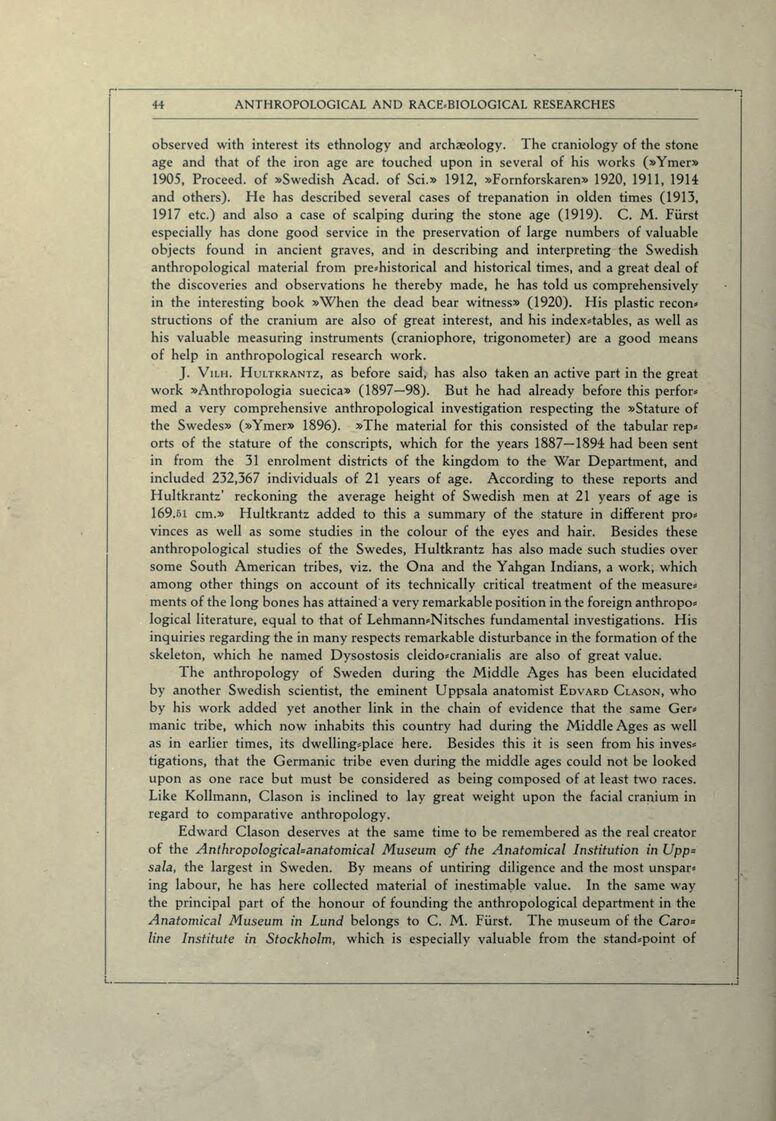
Full resolution (JPEG) - On this page / på denna sida - Part I - Professor Martin Ramström, Uppsala, Anthropological and Race-biological Researches in Sweden

<< prev. page << föreg. sida << >> nästa sida >> next page >>
Below is the raw OCR text
from the above scanned image.
Do you see an error? Proofread the page now!
Här nedan syns maskintolkade texten från faksimilbilden ovan.
Ser du något fel? Korrekturläs sidan nu!
This page has never been proofread. / Denna sida har aldrig korrekturlästs.
observed with interest its ethnology and archaeology. The craniology of the stone
age and that of the iron age are touched upon in several of his works (»Ymer»
1905, Proceed. of »Swedish Acad. of Sci.» 1912, »Fornforskaren» 1920, 1911, 1914
and others). He has described several cases of trepanation in olden times (1913,
1917 etc.) and also a case of scalping during the stone age (1919). C. M. Furst
especially has done good service in the preservation of large numbers of valuable
objects found in ancient graves, and in describing and interpreting the Swedish
anthropological material from pre«historical and historical times, and a great deal of
the discoveries and observations he thereby made, he has told us comprehensively
in the interesting book »When the dead bear witness» (1920). His plastic recon«
structions of the cranium are also of great interest, and his index«tables, as well as
his valuable measuring instruments (craniophore, trigonometer) are a good means
of help in anthropological research work.
J. Vilh. Hultkrantz, as before said, has also taken an active part in the great
work »Anthropologia suecica» (1897—98). But he had already before this perfor«
med a very comprehensive anthropological investigation respecting the »Stature of
the Swedes» (»Ymer» 1896). »The material for this consisted of the tabular rep«
orts of the stature of the conscripts, which for the years 1887—1894 had been sent
in from the 31 enrolment districts of the kingdom to the War Department, and
included 232,367 individuals of 21 years of age. According to these reports and
Hultkrantz’ reckoning the average height of Swedish men at 21 years of age is
169.51 cm.» Hultkrantz added to this a summary of the stature in different pro«
vinces as well as some studies in the colour of the eyes and hair. Besides these
anthropological studies of the Swedes, Hultkrantz has also made such studies over
some South American tribes, viz. the Ona and the Yahgan Indians, a work, which
among other things on account of its technically critical treatment of the measure«
ments of the long bones has attained a very remarkable position in the foreign anthropo«
logical literature, equal to that of Lehmann«Nitsches fundamental investigations. His
inquiries regarding the in many respects remarkable disturbance in the formation of the
skeleton, which he named Dysostosis cleido«cranialis are also of great value.
The anthropology of Sweden during the Middle Ages has been elucidated
by another Swedish scientist, the eminent Uppsala anatomist Edvard Clason, who
by his work added yet another link in the chain of evidence that the same Ger«
manic tribe, which now inhabits this country had during the Middle Ages as well
as in earlier times, its dwelling«place here. Besides this it is seen from his inves«
tigations, that the Germanic tribe even during the middle ages could not be looked
upon as one race but must be considered as being composed of at least two races.
Like Kollmann, Clason is inclined to lay great weight upon the facial cranium in
regard to comparative anthropology.
Edward Clason deserves at the same time to be remembered as the real creator
of the AnthropologicaUanatomical Museum of the Anatomical Institution in Upp=
sala, the largest in Sweden. By means of untiring diligence and the most unspar«
ing labour, he has here collected material of inestimable value. In the same way
the principal part of the honour of founding the anthropological department in the
Anatomical Museum in Lund belongs to C. M. Furst. The museum of the Caro=
line Institute in Stockholm, which is especially valuable from the stand«point of
L.
<< prev. page << föreg. sida << >> nästa sida >> next page >>